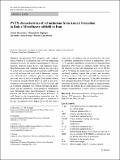| dc.contributor.author | Shariatinia, Zeinab | |
| dc.contributor.author | Haghighi, Manouchehr | |
| dc.contributor.author | Shafiei, Ali | |
| dc.contributor.author | Feiznia, Sadat | |
| dc.contributor.author | Zendehboudi, Sohrab | |
| dc.date.accessioned | 2016-10-24T16:19:28Z | |
| dc.date.available | 2016-10-24T16:19:28Z | |
| dc.date.issued | 2014-12 | |
| dc.date.submitted | 2012-03 | |
| dc.identifier.issn | 1437-3254 | |
| dc.identifier.issn | 1437-3262 | |
| dc.identifier.uri | http://hdl.handle.net/1721.1/104941 | |
| dc.description.abstract | Incorporating PVT properties and compositional evolution of oil inclusions into reservoir engineering simulator protocols can enhance understanding of oil accumulation, reservoir charge history, and migration events. Microthermometry and volumetric analysis have proven to be useful tools in compositional reconstitution and PT studies of oil inclusions and were used to determine composition, thermodynamic conditions, physical properties, and gas-to-oil ratios of heavy oil samples from Asmari carbonate reservoir in Kuh-e-Mond heavy oil field in Iran. PVT properties were predicted using a PVT black-oil model, and an acceptable agreement was observed between the experiments and the simulations. Homogenization temperatures were determined using microthermometry techniques in dolomite and calcite cements of the Asmari Formation, as well. Based on the homogenization temperature data, the undersaturated hydrocarbon mixture prior to formation of the gas cap migrated with a higher gas-to-oil ratio from a source rock. According to the oil inclusion data, the onset of carbonate cementation occurred at temperatures above 45 °C and that cementation was progressive through burial diagenesis. PVT black-oil simulator results showed that the reservoir pressure and temperature were set at 100 bar and 54 °C during the initial stages of oil migration. Compositional modeling implies that primary and secondary cracking in source rocks were responsible for retention of heavy components and migration of miscible three-phase flow during hydrocarbon evolution. The PT evolution of the petroleum inclusions indicates changes in thermodynamic properties and mobility due to phenomena such as cracking, mixing, or/and transport at various stages of oil migration. | en_US |
| dc.publisher | Springer Berlin Heidelberg | en_US |
| dc.relation.isversionof | http://dx.doi.org/10.1007/s00531-014-1101-y | en_US |
| dc.rights | Article is made available in accordance with the publisher's policy and may be subject to US copyright law. Please refer to the publisher's site for terms of use. | en_US |
| dc.source | Springer Berlin Heidelberg | en_US |
| dc.title | PVTX characteristics of oil inclusions from Asmari formation in Kuh-e-Mond heavy oil field in Iran | en_US |
| dc.type | Article | en_US |
| dc.identifier.citation | Shariatinia, Zeinab et al. “PVTX Characteristics of Oil Inclusions from Asmari Formation in Kuh-E-Mond Heavy Oil Field in Iran.” International Journal of Earth Sciences 104.3 (2015): 603–623. | en_US |
| dc.contributor.department | Massachusetts Institute of Technology. Department of Chemical Engineering | en_US |
| dc.contributor.mitauthor | Zendehboudi, Sohrab | |
| dc.relation.journal | International Journal of Earth Sciences | en_US |
| dc.eprint.version | Author's final manuscript | en_US |
| dc.type.uri | http://purl.org/eprint/type/JournalArticle | en_US |
| eprint.status | http://purl.org/eprint/status/PeerReviewed | en_US |
| dc.date.updated | 2016-08-18T15:28:30Z | |
| dc.language.rfc3066 | en | |
| dc.rights.holder | Springer-Verlag Berlin Heidelberg | |
| dspace.orderedauthors | Shariatinia, Zeinab; Haghighi, Manouchehr; Shafiei, Ali; Feiznia, Sadat; Zendehboudi, Sohrab | en_US |
| dspace.embargo.terms | N | en |
| dc.identifier.orcid | https://orcid.org/0000-0002-9088-3059 | |
| mit.license | PUBLISHER_POLICY | en_US |
